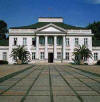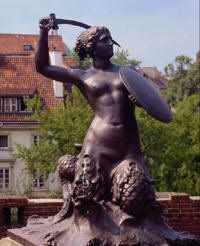In dieser Stadt
hat alles angefangen - hier lernte ich für das Leben, hier leben noch meine
Verwandten, Freunde und Bekannte. Hierher komme ich immer noch sehr gerne
zurück, um sie und all die wunderschönen Plätze aus meiner Kindheit und Jugend
wieder zu besuchen .
Warszawa
|

|
1955 wurde der
Kulturpalast (Pałac
Kultury i Nauki) fertig gebaut. Es ist das höchste Gebäude in
Warschau bis heute (und das seit über 50 Jahren). Es hat 42
Stockwerke und ist 231 Meter hoch.
Es war ein Geschenk von Polens damaligem Freund, Russland. In dieser
Zeit gab es in Europa nur ein höheres Gebäude als den Kulturpalast
in Warschau, und zwar die Moskauer Universität. |
It was raised in 1819-1822 for Grand Duke Constantine according to a
design by Jakub Kubicki. The interior decorations were kept in rich classicistic
style and the palace was furnished with period furniture.
 When Poland regained
its independence, the palace became the seat of Marshal Jozef Pilsudski, and
after 1945 it served as a seat of the state highest authorities. In 1989-1994 the Belvedere Palace
was the residence. In 1995 an exhibition devoted to Jozef Pilsudski was arranged
in the palace.
When Poland regained
its independence, the palace became the seat of Marshal Jozef Pilsudski, and
after 1945 it served as a seat of the state highest authorities. In 1989-1994 the Belvedere Palace
was the residence. In 1995 an exhibition devoted to Jozef Pilsudski was arranged
in the palace.
In the years 1677-1696, close to the city of Warsaw, a sumptuous Baroque
residence was raised
 for King John III Sobieski and his wife Mrysienka according
to a design by Augustyn Locci. Many outstanding artists and architects
participated in the creation of the palace, including Michelangelo Palloni and
Andrzej Schluter. After King's death in 1696 the Wilanow residence
fell into a decline. It was saved by Elzbieta Sieniawska nee Lubomirska who
bought it in 1720 and continued its extension and remodelling throughout the
first half of the 18th century. In 1799 the palace got into the hands of
Stanislaw Kostka Potocki, a devoted collector of antique objects and mementos
connected with John III Sobieski. The Branicki family owned the palace from the
end of the 19th century until 1945. Carefully renovated after the Second World
War, it has become a museum.
for King John III Sobieski and his wife Mrysienka according
to a design by Augustyn Locci. Many outstanding artists and architects
participated in the creation of the palace, including Michelangelo Palloni and
Andrzej Schluter. After King's death in 1696 the Wilanow residence
fell into a decline. It was saved by Elzbieta Sieniawska nee Lubomirska who
bought it in 1720 and continued its extension and remodelling throughout the
first half of the 18th century. In 1799 the palace got into the hands of
Stanislaw Kostka Potocki, a devoted collector of antique objects and mementos
connected with John III Sobieski. The Branicki family owned the palace from the
end of the 19th century until 1945. Carefully renovated after the Second World
War, it has become a museum.
While touring the palace interiors, our special attention is drawn by King's
apartments and the Polish Portrait Gallery. The palace is surrounded by a vast
park. A magnificent collection of posters can be admired in the Poster Museum,
housed by one of the palatial outbuildings.
Originally Gothic in style, founded in the early 15th century to be a
seat of Mazovian Dukes. The extension works started in 1568 on the initiative of
King Sigismund Augustus; its considerable remodelling took place during the
reign of King Sigismund III who transferred the capital of Poland from Cracow to
Warsaw.
The works were carried out in the years 1598-1619 under the guidance of the
royal architect Jan Trevano. A huge five-wing, early Baroque construction was
erected with an inner yard and a tall clock-tower.
The castle (
The vast Royal Castle which occupies the Eastern side of Plac Zamkowsky was
completely rebuilt between 1971 and 1984, having been reduced to a mound of
rubble in 1945. It now houses an extremely popular museum (go early or expect to
queue for a very long time.) had a
function of and official royal seat and the seat of a number of Commonwealth
offices. In the mid-18th century its northeastern wing was remodelled for King
Augustus III according to Gaetano Chiaveri's design: it received a new late
Baroque appearence. The official interiors of the castle acquired their
final shape during the reconstruction works carried out during the reign if King
Stanislaus Augustus Poniatowski. In the years 1765-1794 a sequence of chambers
and rooms were prepared and furnished in the eastern wing according to a design
by Dominik Merlini and Jan Christian Kamsetzer.
The Third of May Constitution was passed here in 1791. During the inter-war
period the castle was the seat of Polish presidents. On September 17, 1939, it
was bombed and burnt, its destruction was completed on October 25, 1944, when
the Nazis set explosives in the castle walls and blew it up. The reconstruction
works were undertaken in 1971 and carried out under the guidance of Jan
Boguslawski. The interiors were faithfully reconstructed and furnished thanks to
the donations and effort of the whole Polish nation.
The park took its name from the already existing 17th century bath house
raised for Stanislaw Herakliusz Lubomirski by Tylman of Gameran. The bath house
was bought from him by King Stanislaw Augustus Poniatowski in 1764, who had it
converted into a summer residence according to Dominik Merlini's design. In 1784
the southern elevation was remodelled, but some of its Baroque elements were
preserved. During the next four years the palace was enlarged on the side of its
northern elevation which, together with its monumental portico, received
classicistic appearence.
Similar heterogeneity is characteristic of the palace interior decorations.
Along with the workson the palace, other construction works were carried out in
the park and the following buildings were raised: the White Cottage (1774-1777),
Myslewicki Palace (1775-1778), Old Orangery Theatre (1786-1788), and the Theatre
on the Island (1790). The Lazienki Palace,
partly destroyed by the last war ravages, is one of the most charming, little
private royal residences of that time. The beautiful English park with ponds and
canals adds much to the palace's delightful appearence.
A memorial to Frederic Chopin designed by Waclaw Szymanowski stands in the park
on the Ujazdowskie Avenue side. Free public concerts of Chopin music are given
there in summer time.
The old, popular Polish song stated: "...Warsaw is
lovable, Warsaw is lovable. There one could find happiness, there one could
loose own heart!...". We agree with this statement and give you the
opportunity to visit even more of those lovable places called Warsaw than you
could think they exist in Warsaw
in the U.S.A..
 History of Warsaw
History of Warsaw
Warsaw is older than it looks: the first settlements in the area stretch back to
the 10th century and the first records back to the 11th. Around the middle of
the 11th, someone thought it noteworthy to report an ominous event for a city
later razed again and again: a wooden fort belonging to the Mazowiecki Princes
was burned in Jazdow during a Lithuanian-Russian raid. The fort was burned again
in 1281 and most likely never rebuilt .
.
But north of Jazdow, they built a better replacement at the end of the 13th
century on the site where today stands the Royal Castle of Warsaw. Enclosed in
protective walls, the Mazovian Princes claimed this area as their seat of power
in 1413, and what is now known as Warsaw began to grow.
But the neutral Mazovian princedom did not remain so for long. In 1526,
when the Mazowiecki line failed to produce heirs, the entire Mazowsze region,
including Warsaw, was incorporated into the Polish crown. Still, Warsaw remained
a political backwater until Poland and Lithuanian unified in 1569. It was an
issue of geographical convenience: Warsaw was closer to the Lithuanian capital
of Vilnius. Only 4 short years later, the kings were being elected here, and 27
years after the unification King Zygmunt III Waza moved the capital from Krakow
to Warsaw. Some claim he moved due to the burning of Wawel Castle in Krakow, but
others note how much closer Warsaw was to Zygmunt's home country of Sweden.
Despite this royal closeness, Warsaw was soon to suffer terribly from the
Swedes. Between 1655 and 1658, Warsaw was thrice besieged and entirely plundered
by the Swedish and Siedmiogrodzkie forces. Years later Henryk Sienkiewicz
eloquently described these years, known as "The Deluge", in his
Trilogy. Warsaw rallied following the election of King Jan III Sobieski, but
continued internal ferment and yet another invasion by the Swedish King Charles
XII kept Warsaw destabilized for most of the 18th century as well. But before
the century ended, the rule of the Saski Family stabilized the political
situation and Warsaw again became an important center of culture, education, and
enlightenment.
 This
period, led by King Stanislaw August Poniatowski, was later coined as Warsaw's
second "golden era" when it was transformed into a modern city.
Crowning these architectural achievements, the first European, democratic
constitution (second only to that of the US) was declared on May 3, 1791.
This
period, led by King Stanislaw August Poniatowski, was later coined as Warsaw's
second "golden era" when it was transformed into a modern city.
Crowning these architectural achievements, the first European, democratic
constitution (second only to that of the US) was declared on May 3, 1791.
Ironically, at this same time, Poland's ongoing partitions limited the
freedom of the city. In 1794, Varsovians joined the heroic, albeit unsuccessful,
Kosciuszko Uprising by attacking Russian troops stationed in the capital. While
initially a success, the uprising was eventually squashed and Warsaw along with
a large part of Mazowsze region was incorporated into Prussia in 1795. Warsaw
had a brief respite in 1807 when Napoleon established a Duchy of Warsaw, but
this ended in 1830 when the Russians took control until WWI began.
When Poland regained its independence in 1918, Varsovians worked
energetically to revamp and expand the city and its infrastructure. But war put
an end to that. Germany invaded Poland on the 1st of September, 1939 and for 28
days the Poles resisted, but Warsaw fell despite their heroic efforts. Such
resistance continued throughout the war, marked notably by two uprisings in 1943
and 1944.
In April of 1943, the Jewish Ghetto Uprising erupted and lasted for one month
of intense fighting before the German army managed to overcome the area and
liquidate the ghetto, and along with it the centuries old population. The
following year, the Warsaw Uprising began in the hopes of liberating the city
from the Germans, but the Soviet army - camped across the Vistula - did not help
and after 63 days of bitter house-to-house fighting the attempt to liberate the
city failed. Following the Uprising, Hitler ordered Warsaw destroyed;
consequently 85% of the city was reduced to rubble over the following 3 months.
Only in January of the next year did the Soviet army finally cross the river to
enter the decimated city.
 After
WWII ended, Warsaw was rebuilt. The Royal Castle and the surrounding Old Town
were painstakingly reconstructed from pictures rendered in the 17th and 18th
centuries. Unfortunately, construction in the rest of the city was not based on
the past, and 'real socialism' survives today in the myriad blocks and bunkers
of modern day Warsaw. In 1989, Poland again became a democracy and today thrives
as never before. One hopes it has entered its third 'golden age'.
After
WWII ended, Warsaw was rebuilt. The Royal Castle and the surrounding Old Town
were painstakingly reconstructed from pictures rendered in the 17th and 18th
centuries. Unfortunately, construction in the rest of the city was not based on
the past, and 'real socialism' survives today in the myriad blocks and bunkers
of modern day Warsaw. In 1989, Poland again became a democracy and today thrives
as never before. One hopes it has entered its third 'golden age'.
 Legenda
o Syrence warszawskiej Legenda
o Syrence warszawskiej |
 Die Legende über die
Warschauer Sirene Die Legende über die
Warschauer Sirene |
Dawno dawno
temu przypłynęły z Atlantyku na Bałtyk dwie siostry - syreny; piękne
kobiety z rybimi ogonami, zamieszkujące w głębinach mórz.
Jedna z nich upodobała sobie skały w cieśninach duńskich i do tej pory
możemy ją zobaczyć siedzącą na skale u wejścia do portu w Kopenhadze.
Druga dopłynęła aż do wielkiego nadmorskiego portu Gdańsk, a potem Wisłą
popłynęła w górę jej biegu. Podobno właśnie u podnóża dzisiejszego
Starego Miasta wyszła z wody na piaszczysty brzeg, aby odpocząć, a że
miejsce spodobało się jej, postanowiła tu zostać.
Rychło rybacy zauważyli, że ktoś podczas ich połowu wzburza fale Wisły,
plącze sieci i wypuszcza ryby z więcierzy. Ponieważ jednak syrena
oczarowywała ich swym pięknym śpiewem, nic jej nie zrobili.
Pewnego razu bogaty kupiec zobaczył syrenę i usłyszał jej piękny śpiew.
Szybko przeliczył, ile zarobi, jeżeli uwięzi syrenę i będzie ją
pokazywać na jarmarkach. Podstępem ujął syrenę i uwięził ją w drewnianej
szopie, bez dostępu do wody. Skargi syreny usłyszał młody parobek, syn
rybaka i z pomocą przyjaciół w nocy uwolnił ją.
Syrena z wdzięczności za to, że mieszkańcy stanęli w jej obronie
obiecała im, że w razie potrzeby oni też mogą liczyć na jej pomoc. I
dlatego warszawska syrena jest uzbrojona - ma miecz i tarczę dla obrony
naszego miasta.
|
Vor einer langen, langen
Zeit kamen aus dem Baltischen Meer zwei Schwestern - wunderschöne
Sirenen, Frauen mit Fisch-Schwänzen, die in den Tiefen der Meere
wohnten. Einer von ihnen haben es die
Felsen und Gewässer im heutigen Dänemark angetan und bis heute kann man
sie auf den Felsen vor Kopenhagen sitzen sehen.
Die andere schwamm bis Danzig, dann die
Weichsel hinunter, dem Strom entgegen. Anscheinend kam sie aus
dem Wasser heraus ans Ufer, um sich zu erholen, genau da, wo heute die Altstadt
von Warschau ist. Da ihr das sandige Ufer sehr gefiel, beschloss sie, zu bleiben.
Bald bemerkten die Fischer der
Umgebung, dass jemand die Wellen der Weichsel stürmisch macht und die
Fische aus den Netzen befreit. Da aber die Sirene übernatürlich schön
singen konnte, waren die Fischer so verzaubert, dass sie ihr alles Andere
verziehen.
Eines Tages sah ein Kaufmann die Sirene
und hörte auch ihre zauberhafte Stimme. Schnell wurde ihm klar, wie
viel er für sie bekommen könnte, wenn es ihm gelänge, sie zu fangen. Mit
einer List fing er sie und hielt sie in einem Holzschuppen ohne Zugang zum
Wasser fest. Ihr klägliches Singen wurde aber eines Tages von einem jungen Fischer
gehört. Mit Hilfe von Freunden gelang es ihm, die Sirene aus
der Gefangenschaft zu befreien.
Aus Dankbarkeit für den Einsatz
versprach die Sirene den Fischern, dass sie ihnen, wann immer sie Hilfe
bräuchten, beistehen würde. Daher ist die Warschauer Sirene bewaffnet -
sie hat Schwert und Schild, um Warschau vor Feinden zu schützen.
|
Fotos aus Warschau 
back
 Mars
Mars
Copyright © 2004 Alle Rechte vorbehalten.
Stand:
31. Oktober 2008


 When Poland regained
its independence, the palace became the seat of Marshal Jozef Pilsudski, and
after 1945 it served as a seat of the state highest authorities. In 1989-1994 the Belvedere Palace
was the residence. In 1995 an exhibition devoted to Jozef Pilsudski was arranged
in the palace.
When Poland regained
its independence, the palace became the seat of Marshal Jozef Pilsudski, and
after 1945 it served as a seat of the state highest authorities. In 1989-1994 the Belvedere Palace
was the residence. In 1995 an exhibition devoted to Jozef Pilsudski was arranged
in the palace. for King John III Sobieski and his wife Mrysienka according
to a design by Augustyn Locci. Many outstanding artists and architects
participated in the creation of the palace, including Michelangelo Palloni and
Andrzej Schluter. After King's death in 1696 the Wilanow residence
fell into a decline. It was saved by Elzbieta Sieniawska nee Lubomirska who
bought it in 1720 and continued its extension and remodelling throughout the
first half of the 18th century. In 1799 the palace got into the hands of
Stanislaw Kostka Potocki, a devoted collector of antique objects and mementos
connected with John III Sobieski. The Branicki family owned the palace from the
end of the 19th century until 1945. Carefully renovated after the Second World
War, it has become a museum.
for King John III Sobieski and his wife Mrysienka according
to a design by Augustyn Locci. Many outstanding artists and architects
participated in the creation of the palace, including Michelangelo Palloni and
Andrzej Schluter. After King's death in 1696 the Wilanow residence
fell into a decline. It was saved by Elzbieta Sieniawska nee Lubomirska who
bought it in 1720 and continued its extension and remodelling throughout the
first half of the 18th century. In 1799 the palace got into the hands of
Stanislaw Kostka Potocki, a devoted collector of antique objects and mementos
connected with John III Sobieski. The Branicki family owned the palace from the
end of the 19th century until 1945. Carefully renovated after the Second World
War, it has become a museum.
 .
.